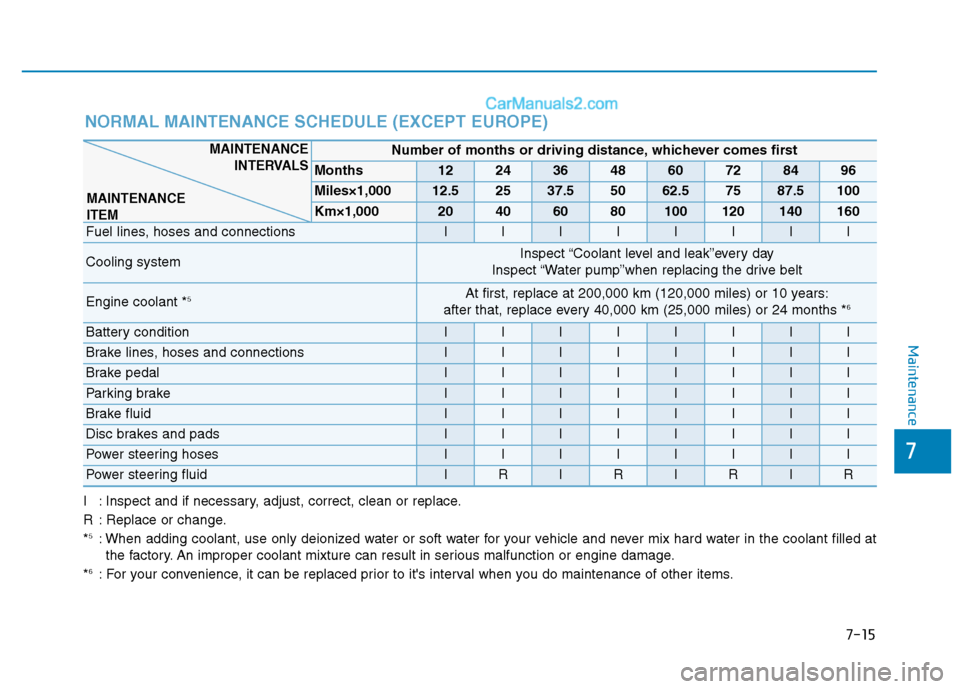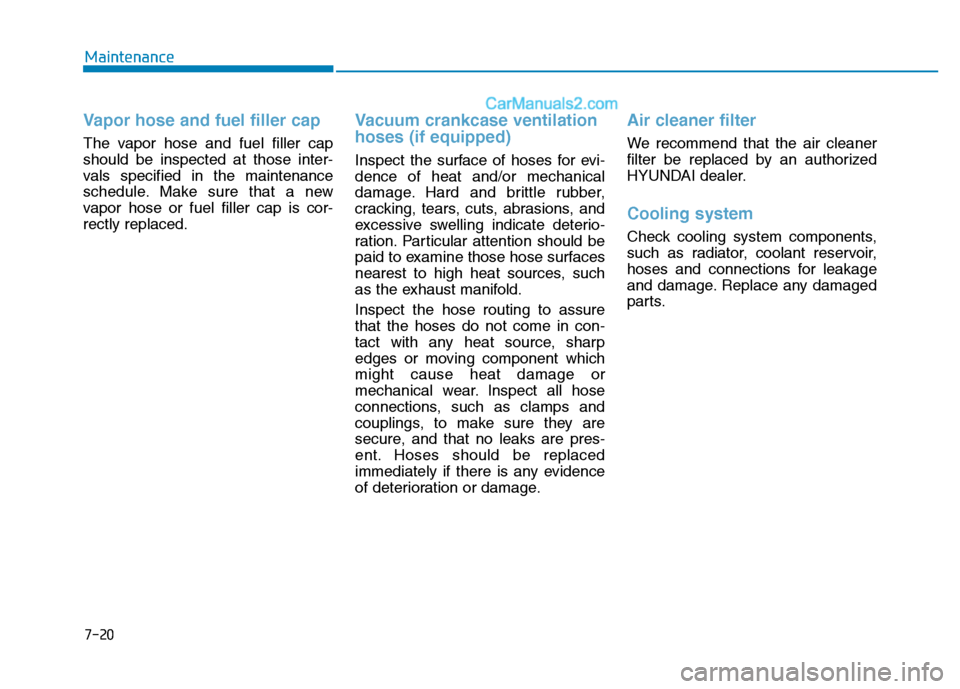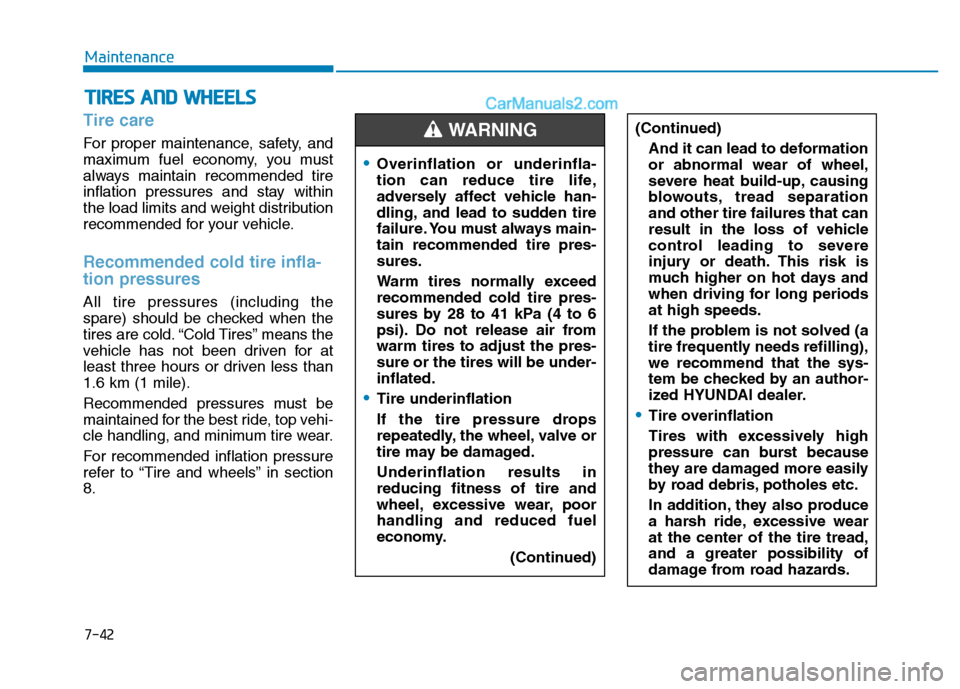2016 Hyundai H350 fuel
[x] Cancel search: fuelPage 371 of 473

7-8
Maintenance
The following lists are vehicle checks and inspections that should be per-
formed at the frequencies indicated
to help ensure safe, dependable
operation of your vehicle. If you have
any question, we recommend that
you consult an authorized HYUNDAI
dealer.
These Owner Maintenance Checks
are generally not covered by war-
ranties and you may be charged for
labor, parts and lubricants used.Owner maintenance schedule
When you stop for fuel:
Check the engine oil level.
Check coolant level in coolantreservoir.
Check the windshield washer fluid level.
Look for low or under-inflated tires.
While operating your vehicle:
Note any changes in the sound of the exhaust or any smell of
exhaust fumes in the vehicle.
Check for vibrations in the steering wheel. Notice any increased steer-
ing effort or looseness in the steer-
ing wheel, or change in its straight-ahead position.
Notice if your vehicle constantly turns slightly or “pulls” to one side
when traveling on smooth, levelroad.
When stopping, listen and check for unusual sounds, pulling to one
side, increased brake pedal travel
or “hard-to-push” brake pedal.
If any slipping or changes in the operation of your transmission
occurs, check the transmission
fluid level.
Check manual transmission opera- tion, including clutch operation.
Check parking brake.
Check for fluid leaks under your vehicle (water dripping from the air
conditioning system during or after
use is normal).
OOWW NNEERR MM AAIINN TTEENN AANN CCEE
Be careful when checking your
engine coolant level when the
engine is hot. Scalding hot
coolant and steam may blow
out under pressure. This could
cause burns or other serious
injury.
WARNING
Page 374 of 473

7-11
7
Maintenance
NORMAL MAINTENANCE SCHEDULE (FOR EUROPE)
I : Inspect and if necessary, adjust, correct, clean or replace.
R : Replace or change.*1
: Adjust alternator and power steering (and water pump drive belt) and air conditioner drive belt (if equipped).
Inspect and if necessary correct or replace.
* 2
: Check the engine oil level and leak every 500 km (350 miles) or before starting a long trip.
* 3
: This maintenance schedule depends on fuel quality. It is applicable only when using a qualified fuel <"EN590 or equivalent">.
If the diesel fuel specification doesn't meet the EN590, it must be replaced more frequently. If there are some important safety
matters like fuel flow restriction, surging, loss of power, hard starting problem etc, replace the fuel filter immediately rega rdless
of maintenance schedule and we recommend that you consult an authorized HYUNDAI dealer.
* 4
: Fuel filter warning light comes on, you should replace fuel filter before the next scheduled service.
Number of months or driving distance, whichever comes first
Months24487296120144168192
Miles×1,0002037.5607590110130150
Km×1,000306090120150180210240
Drive Belts * 1
and idlerAt first, inspect 60,000 km (37,500 miles) or 48 months
After that, inspect every 30,000 km (20,000 miles) or 24 months
Engine oil and engine oil filter * 2Except RussiaReplace every 30,000 km (20,000 miles) or 24 months
For RussiaReplace every 15,000 km (1,000 miles) or 12 months
Air cleaner filterIRIRIRIR
Vapor hose and fuel filter capIIIIIIII
Vacuum hose (for EGR & throttle body) (if equipped)IIIIIIII
Fuel Filter Cartridge *3
* 4IRIRIRIR
Fuel line hoses and connectionsIIIIIIII
MAINTENANCE
INTERVALS
MAINTENANCE ITEM
Page 377 of 473

7-14
Maintenance
NORMAL MAINTENANCE SCHEDULE (EXCEPT EUROPE)
Number of months or driving distance, whichever comes first
Months1224364860728496
Miles×1,00012.52537.55062.57587.5100
Km×1,000204060801001120140160
Drive belts *1
and idlerAt first, inspect 60,000 km (37,500 miles) or 48 months
After that, inspect every 30,000 km (20,000 miles) or 24 months
Engine oil and engine oil filter * 2Replace every 10,000 km (6,200 miles) or 12 months
Air cleaner filterIRIRIRIR
Vapor hose and fuel filler capIIIIIIII
Vacuum hose (for EGR & throttle body) (if equipped)IIIIIIII
Fuel filter cartridge *3
* 4IRIRIRIR
MAINTENANCE
INTERVALS
MAINTENANCE ITEM
I : Inspect and if necessary, adjust, correct, clean or replace.
R : Replace or change.* 1
: Adjust alternator and power steering (and water pump drive belt) and air conditioner drive belt (if equipped).
Inspect and if necessary correct or replace.
* 2
: Check the engine oil level and leak every 500 km (350 miles) or before starting a long trip.
* 3
: This maintenance schedule depends on fuel quality. It is applicable only when using a qualified fuel < "EN590 or equivalent">.
If the diesel fuel specification doesn't meet the EN590, it must be replaced more frequently. If there are some important safety
matters like fuel flow restriction, surging, loss of power, hard starting problem etc, replace the fuel filter immediately rega rdless
of maintenance schedule and we recommend that you consult an authorized HYUNDAI dealer.
* 4
: Fuel filter warning light comes on, you should replace fuel filter before the next scheduled service.
Page 378 of 473

7-15
7
Maintenance
NORMAL MAINTENANCE SCHEDULE (EXCEPT EUROPE)
Number of months or driving distance, whichever comes first
Months1224364860728496
Miles×1,00012.52537.55062.57587.5100
Km×1,00020406080100120140160
Fuel lines, hoses and connectionsIIIIIIII
Cooling systemInspect “Coolant level and leak”every day
Inspect “Water pump”when replacing the drive belt
Engine coolant * 5At first, replace at 200,000 km (120,000 miles) or 10 years:
after that, replace every 40,000 km (25,000 miles) or 24 months * 6
Battery conditionIIIIIIII
Brake lines, hoses and connectionsIIIIIIII
Brake pedalIIIIIIII
Parking brakeIIIIIIII
Brake fluidIIIIIIII
Disc brakes and padsIIIIIIII
Power steering hosesIIIIIIII
Power steering fluidIRIRIRIR
MAINTENANCE
INTERVALS
I : Inspect and if necessary, adjust, correct, clean or replace.
R : Replace or change.*5
: When adding coolant, use only deionized water or soft water for your vehicle and never mix hard water in the coolant filled at
the factory. An improper coolant mixture can result in serious malfunction or engine damage.
* 6
: For your convenience, it can be replaced prior to it's interval when you do maintenance of other items.
MAINTENANCE ITEM
Page 382 of 473

7-19
7
Maintenance
EEXX PPLLAA NN AATTIIOO NN OO FF SS CC HH EEDD UU LLEE DD MM AAIINN TTEENN AANN CCEE IITT EEMM SS
Engine oil and filter
The engine oil and filter should be
changed at the intervals specified in
the maintenance schedule. If the
vehicle is being driven in severe con-
ditions, more frequent oil and filterchanges are required.
Drive belts
Inspect all drive belts for evidence of
cuts, cracks, excessive wear or oil
saturation and replace if necessary.
Drive belts should be checked peri-
odically for proper tension and
adjusted as necessary.
Fuel filter (cartridge)
A clogged filter can limit the speed at
which the vehicle may be driven,damage the emission system and
cause multiple issues such as hard
starting. If an excessive amount of
foreign matter accumulates in the
fuel tank, the filter may require
replacement more frequently.
After installing a new filter, run the
engine for several minutes, and
check for leaks at the connections.
We recommend that the fuel filter be
replaced by an authorized HYUNDAI
dealer.
Fuel lines, fuel hoses and con- nections
Check the fuel lines, fuel hoses and
connections for leakage and dam-
age. We recommend that the fuel
lines, fuel hoses and connection be
replaced by an authorized HYUNDAI
dealer.
When you are inspecting the
belt, place the ignition switch in
the LOCK/OFF or ACC position.
CAUTION
In case the fuel filter is clogged
due to not conforming to the
maintenance period, the fuel
injection equipment may supply
the fuel insufficiently, which
may damage the fuel injectionequipment and cause the
engine to stall at worst cases.
CAUTION
Diesel only
Never work on injection system with engine running or within 30seconds after shutting off
engine. High pressure pump,
rail, injectors and high pressurepipes are subject to high pres-
sure even after the engine
stopped. The fuel jet produced
by fuel leaks may cause serious
injury, if it touch the body.
People using pacemakers
should not move than 30cm
closer to the ECU or wiring har-
ness within the engine room
while engine is running, sincethe high currents in the
Common Rail system produce
considerable magnetic fields.
WARNING
Page 383 of 473

7-20
Maintenance
Vapor hose and fuel filler cap
The vapor hose and fuel filler cap should be inspected at those inter-
vals specified in the maintenance
schedule. Make sure that a new
vapor hose or fuel filler cap is cor-rectly replaced.
Vacuum crankcase ventilation hoses (if equipped)
Inspect the surface of hoses for evi- dence of heat and/or mechanical
damage. Hard and brittle rubber,
cracking, tears, cuts, abrasions, and
excessive swelling indicate deterio-
ration. Particular attention should be
paid to examine those hose surfaces
nearest to high heat sources, such
as the exhaust manifold. Inspect the hose routing to assure that the hoses do not come in con-
tact with any heat source, sharp
edges or moving component whichmight cause heat damage or
mechanical wear. Inspect all hose
connections, such as clamps and
couplings, to make sure they are
secure, and that no leaks are pres-
ent. Hoses should be replaced
immediately if there is any evidence
of deterioration or damage.
Air cleaner filter
We recommend that the air cleaner
filter be replaced by an authorized
HYUNDAI dealer.
Cooling system
Check cooling system components,
such as radiator, coolant reservoir,
hoses and connections for leakage
and damage. Replace any damaged
parts.
Page 393 of 473

7-30
Maintenance
Checking the parking brake
Check the stroke of the parking
brake by counting the number of
“clicks’’ heard while fully applying it
from the released position. Also, the
parking brake alone should securely
hold the vehicle on a fairly steep
grade. If the stroke is more or less
than specified, we recommend that
the system be serviced by an author-
ized HYUNDAI dealer.
Stroke : 7 “clicks’’ at a force of
20 kg (44 lbs, 196 N).
Draining water from fuel filter
The fuel filter for diesel engine plays
an important role of separating water
from fuel and accumulating the waterin its bottom.
If water accumulates inthe fuel filter, the warninglight comes on when the
ignition switch is in the ONposition.
If this warning light turned
on, we recommend that
the system be serviced by
an authorized HYUNDAI
dealer.
Fuel filter cartridge replace- ment
When replacing the fuel filter car-
tridge, we recommend that you
use parts for replacement from an
authorized HYUNDAI dealer.
NOTICE
PP AA RRKK IINN GG BB RRAA KKEE FFUU EELL FF IILL TT EERR (( FF OO RR DD IIEE SSEE LL))
OEU054002
If the water accumulated in the
fuel filter is not drained at prop-
er times, damages to the major
parts such as the fuel system
can be caused by water perme-
ation in the fuel filter.
CAUTION
OEU074016
Page 405 of 473

7-42
Maintenance
Tire care
For proper maintenance, safety, and
maximum fuel economy, you must
always maintain recommended tire
inflation pressures and stay within
the load limits and weight distribution
recommended for your vehicle.
Recommended cold tire infla- tion pressures
All tire pressures (including the
spare) should be checked when the
tires are cold. “Cold Tires” means the
vehicle has not been driven for at
least three hours or driven less than1.6 km (1 mile).
Recommended pressures must be
maintained for the best ride, top vehi-
cle handling, and minimum tire wear.
For recommended inflation pressure
refer to “Tire and wheels” in section8.
TTIIRR EESS AA NN DD WW HHEEEELLSS
Overinflation or underinfla-
tion can reduce tire life,
adversely affect vehicle han-
dling, and lead to sudden tire
failure. You must always main-tain recommended tire pres-sures.
Warm tires normally exceed recommended cold tire pres-
sures by 28 to 41 kPa (4 to 6
psi). Do not release air fromwarm tires to adjust the pres-sure or the tires will be under-inflated.
Tire underinflation
If the tire pressure drops
repeatedly, the wheel, valve or
tire may be damaged. Underinflation results in reducing fitness of tire and
wheel, excessive wear, poorhandling and reduced fuel
economy. (Continued)
(Continued)
And it can lead to deformation or abnormal wear of wheel,
severe heat build-up, causing
blowouts, tread separationand other tire failures that can
result in the loss of vehicle
control leading to severe
injury or death. This risk is
much higher on hot days and
when driving for long periodsat high speeds.
If the problem is not solved (a
tire frequently needs refilling),we recommend that the sys-
tem be checked by an author-
ized HYUNDAI dealer.
Tire overinflation
Tires with excessively high
pressure can burst because
they are damaged more easily
by road debris, potholes etc.
In addition, they also produce
a harsh ride, excessive wearat the center of the tire tread,and a greater possibility of
damage from road hazards.
WARNING